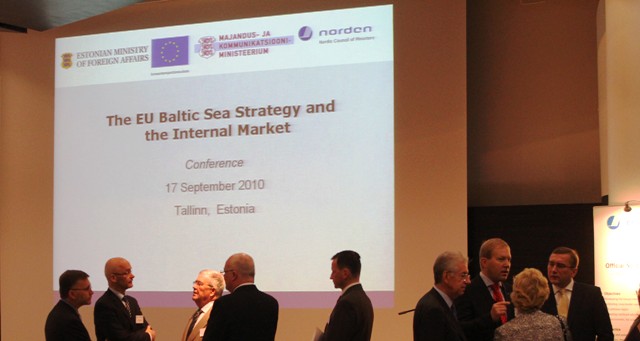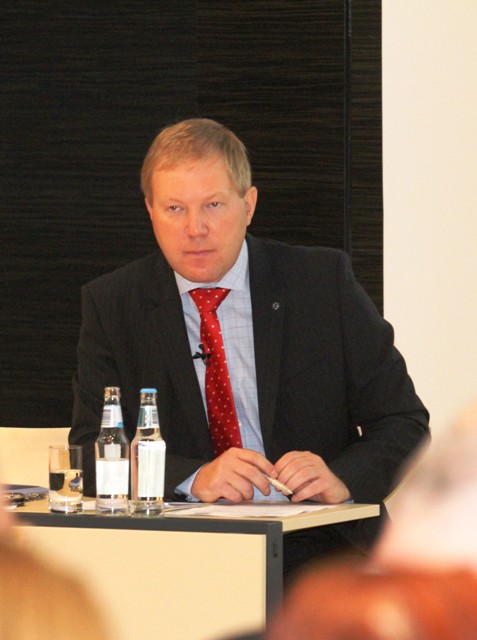|
The Baltic Sea Strategy is an agreement between Germany, Poland, Latvia, Lithuania, Finland, Sweden, Denmark and Estonia to focus on specific policy areas and projects. Its aim is to make the region more visible and more competitive within the European Union. Next I would like to touch on three areas to which Estonia could pay particular attention in the coming years in the context of the Baltic Sea Strategy, taking into consideration its future presidency of the European Union. The countries on the Baltic Sea are closely connected in terms of their concern for the state of its maritime environment. Recent events in the Gulf of Mexico have gotten the world thinking about environmental disasters in general, even those with the least likelihood of taking place, and how to react to them. For the Baltic Sea, in the worst-case scenario, this could mean two fully loaded oil tankers colliding. To minimise the impact of such an accident, action would have to be taken promptly, utilising all of the rescue and clean-up technology available to the countries in the region and under a single, unified command. That is not something for which we are currently prepared. The Baltic Sea Strategy incorporates projects designed to reinforce cooperation in reacting to incidents which occur at sea. The success and further development of these projects is of the utmost importance. As such, it may be possible for Estonia, during its presidency of the European Union, to organise joint training involving all of the countries in the region on dealing with the impact of environmental disasters. Space for wind parks, harbours, fishing and tourism The Baltic Sea is the corridor onto which all of the countries in the region open. Some of us perhaps envied those travelling by sea in spring, when the volcanic ash from Iceland was clogging up Europe's air space. But the Baltic Sea is not only home to passenger vessels and cargo ships: it accommodates wind parks and a myriad of ports and harbours, and has strong ties with fishing and tourism. It is dotted with islands. The seabed is a graveyard of hazardous wrecks and refuse. The Baltic Sea is a fragile ecosystem, and the unique environments it boasts require our protection. There are of course further interests at play, too, and unfortunately they often conflict with one another.What is of primary importance in resolving such conflicts is cooperation in the spatial planning of the Baltic Sea. We should aim to reach a mutual understanding on the principles of such planning if not before, then at least by the time Estonia assumes the presidency of the European Union. At the summit held in Tallinn during Estonia's presidency, the prime minister could distribute among his colleagues locally printed maps of the Baltic Sea that take into account the principles of spatial planning. These maps could mark protected areas and all potential sites for wind parks, gas pipelines, ports, communications cables and navigation routes. This horizontal area is currently supported in the Baltic Sea Strategy by projects directed at, for example, adding to the network of protected marine environments in the region and developing environmentally friendly port services. List of border barriers The countries on the Baltic Sea form part of the internal market of the European Union. This is a single market on which there is free movement of goods, capital, people and services. Many people are saying that the market is not operating effectively to the degree that it could and ought to be. We are hearing from Estonian business operators and workers that they have encountered bureaucratic obstacles on the internal market. Unfortunately, there are even Member States who are not interested in opening up their markets. There is talk of integration fatigue and disappointment in the internal market. This is sad to hear, because everyone would stand to gain from an open internal market operating as effectively as it should be.Estonia has adopted the operating of the internal market in the region as one of its core topics in the Baltic Sea Strategy. By the time Estonia takes on the presidency of the European Union, the internal market policy area of the strategy could be operating as a forum, in a similar fashion to the Freedom of Movement Forum of the Nordic Council of Ministers. A decision could have been made by this period for the forum to issue an annual list of market obstacles that business operators and workers in the region have encountered. This list could include proposals for action to be taken in the relevant Member States to remove these obstacles and deadlines which the Member States take into account. By the end of this period, we want to be able to say, in summarising Estonia's presidency of the European Union, that there is no longer anything on the list of market obstacles in the Baltic Sea region. Needless to say, all of this will require a great deal of work, starting today. The action plan for the Baltic Sea Strategy must be reviewed and updated constantly. This will not be easy to achieve, since the strategy still lacks its own row in the European Union budget. As such, we must also work to ensure that the resources needed for the Baltic Sea Strategy, like those for other regional joint development projects, appear in the new budget prospectus being introduced in 2014. Marko Mihkelson (Pro Patria and Res Publica Union Party) wrote this article in the eve of the high-level conference on the EU Baltic Sea Strategy and the Internal Market held on 17 September 2010. |
||
|
Related links:
|
||
Chairman of the EU Affairs Committee of the Parliament of Estonia: Estonia could take a leaf from the Freedom of Movement Forum of the Nordic Council of Ministers
|
The Baltic Sea Strategy represents a wish to boost cooperation between the citizens, business operators, scientists, officials, interest groups and politicians in the countries within the region so as to maximise its combined potential, which to date has been underused, and to counter skepticism in terms of cross-border undertakings. Six of the eight European Union Members States with coastlines on the Baltic Sea are small countries. But what makes them big is their allies - and where better to find them than among their neighbours? Your neighbours are the people you meet and talk to most often, which is why it is easier to appreciate their problems. By working together, you can implement more ambitious goals. |

 Estonia has already started making preparations for its presidency of the European Union in the first six months of 2018, writes Marko Mihkelson, Chairman of the EU Affairs Committee of the Riigikogu (Parliament of Estonia). Although the world is a dynamically changing place, as the after-effects of the September 11th, 2001 terrorist attacks have shown, it is always beneficial to maintain a longer-term vision and to set objectives. One such vision is undoubtedly Estonia's activity within the European Union, especially in areas which may well prove topical during our period of presidency in eight years' time.
Estonia has already started making preparations for its presidency of the European Union in the first six months of 2018, writes Marko Mihkelson, Chairman of the EU Affairs Committee of the Riigikogu (Parliament of Estonia). Although the world is a dynamically changing place, as the after-effects of the September 11th, 2001 terrorist attacks have shown, it is always beneficial to maintain a longer-term vision and to set objectives. One such vision is undoubtedly Estonia's activity within the European Union, especially in areas which may well prove topical during our period of presidency in eight years' time. Maritime environment and catastrophes
Maritime environment and catastrophes